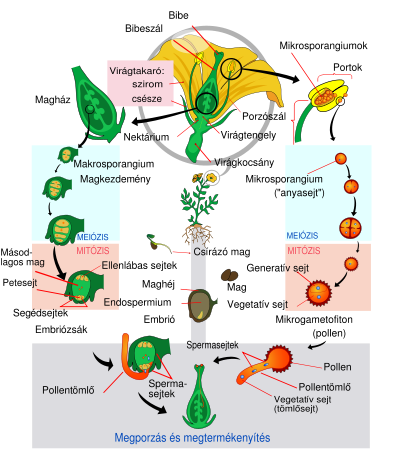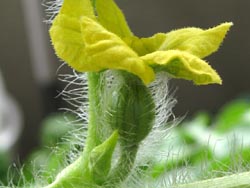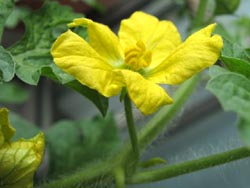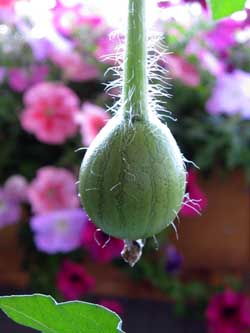Reproduction
How does the Citrillus lanatus reproduce?
 As it is explained on the
Classification page, the Citrullus lanatus is an
angiosperm. This means that it produces flowers and fruit.
The life cycle of an angiosperm is much different from that of a
human. Unlike humans, these organisms go through a process
called alteration of generations. This means, that the Citrullus
lanatus alternates between a diploid sporophyte generation and a
haploid gametophyte generation. The flowers are the site of
sexual reproduction and the male and female flower each partake
in this reproductive process. The anther, located on the male
flower, contains thousands of diploid microsporocytes. Each one
of these microsporocytes goes through meiosis creating haploid
microspores. These microspores then enter the gametophyte stage
by each going through mitosis to make microgametophytes. These
structures are known as pollen. On the female flower, the pistil
contains a number of reproductive organs including the stigma,
style, ovary, and ovules. There is a diploid megasporocyte on
the ovule and it, much like the microsporocytes, goes through
meiosis to form 4 haploid megaspores to enter the gametophyte
stage. However, only one of these megaspores survives. This
megaspore goes through mitosis and produces 7 haploid cells
making up the megagametophyte. Another organism that goes through this life cycle, is the
American chestnut.
As it is explained on the
Classification page, the Citrullus lanatus is an
angiosperm. This means that it produces flowers and fruit.
The life cycle of an angiosperm is much different from that of a
human. Unlike humans, these organisms go through a process
called alteration of generations. This means, that the Citrullus
lanatus alternates between a diploid sporophyte generation and a
haploid gametophyte generation. The flowers are the site of
sexual reproduction and the male and female flower each partake
in this reproductive process. The anther, located on the male
flower, contains thousands of diploid microsporocytes. Each one
of these microsporocytes goes through meiosis creating haploid
microspores. These microspores then enter the gametophyte stage
by each going through mitosis to make microgametophytes. These
structures are known as pollen. On the female flower, the pistil
contains a number of reproductive organs including the stigma,
style, ovary, and ovules. There is a diploid megasporocyte on
the ovule and it, much like the microsporocytes, goes through
meiosis to form 4 haploid megaspores to enter the gametophyte
stage. However, only one of these megaspores survives. This
megaspore goes through mitosis and produces 7 haploid cells
making up the megagametophyte. Another organism that goes through this life cycle, is the
American chestnut.
Female Flowers
Reproduction occurs within the flowers. The watermelon
creates separate male and female flowers, and it is monoecious.
On female flowers, the female reproductive organs, known as eggs, are developed into seeds
when fertilized and are contained within the ovary.
Attached
to the watermelon ovary, are three stigmas.
The female flowers open and wait to be pollinated.
Male Flowers
On male watermelon flowers, the pollen is produced in the anther. In order to reproduce, pollination
must occur.
In
 watermelon, pollination is the process in which an insect
moves pollen from the male flower to the sticky stigma of a
female flower which fertilizes the eggs. When the pollen fertilizes
an egg, it forms a zygote. The zygote will go through a process
called meiosis which is sexual reproduction. (Many eukaryotic
organisms, including humans go through this process.) In order for the
occurrence of a well developed fruit, all three stigmas must be
sufficiently covered in pollen. Even though many insects can
pollinate the watermelon, their most common pollinator is the
honey bee. It is
absolutely necessary for bees to be present in order for
pollination of the Citrullus lanatus to take place. Not
only do they need to be present, but they need to be active as
well. Another plant that goes through a similar pollination
process is called the
common blue violet.
watermelon, pollination is the process in which an insect
moves pollen from the male flower to the sticky stigma of a
female flower which fertilizes the eggs. When the pollen fertilizes
an egg, it forms a zygote. The zygote will go through a process
called meiosis which is sexual reproduction. (Many eukaryotic
organisms, including humans go through this process.) In order for the
occurrence of a well developed fruit, all three stigmas must be
sufficiently covered in pollen. Even though many insects can
pollinate the watermelon, their most common pollinator is the
honey bee. It is
absolutely necessary for bees to be present in order for
pollination of the Citrullus lanatus to take place. Not
only do they need to be present, but they need to be active as
well. Another plant that goes through a similar pollination
process is called the
common blue violet.
Forming Fruit

Watermelon flowers are only viable for one day. Female flowers open
right after sunrise, and most of the pollination takes place in the
morning. The soil must be between the temperatures of 20-35 degrees
Celsius in order to for seeds to germinate. Within days of being
pollinated, the ovary begins forming the very familiar fruit that we
call the watermelon.
What other organisms are apart of the life of the watermelon? Find the answer in interactions!